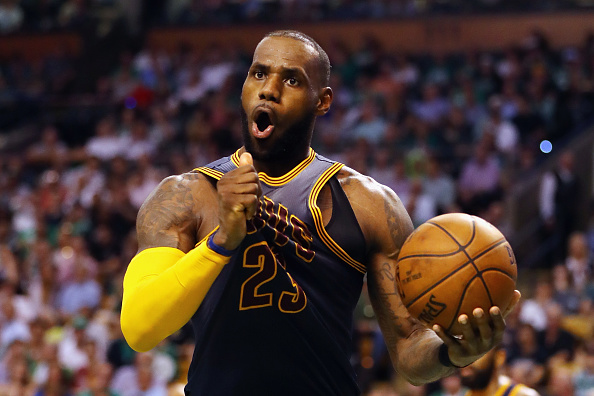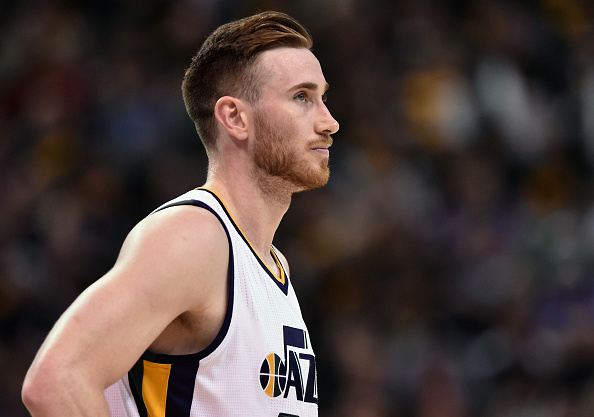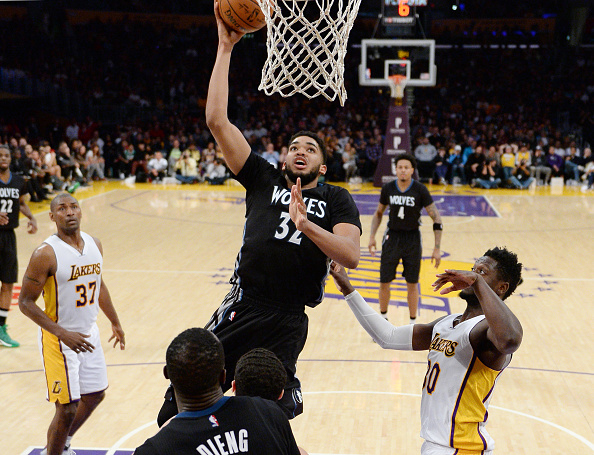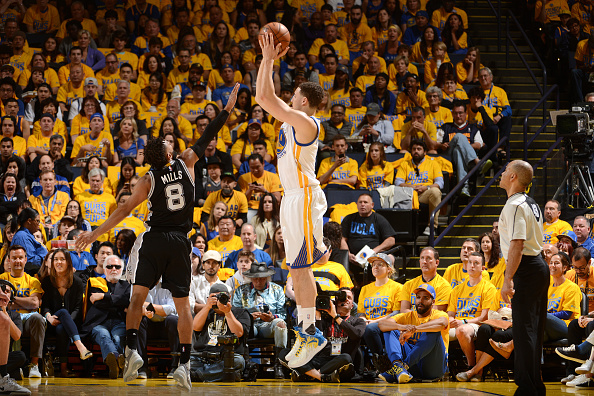
All-NBA Teams, the who, what, when, why and how
As the postseason winds down, matches become increasingly further apart. In fact, if both teams finish their respective sweeps, Golden State on the 22nd and the Cavaliers on the 23rd, then we’ll have to wait for slightly more than a week of basketball-less agony until the NBA Finals (June 1st).
Since basketball and writing about basketball is a welcome distraction from the monotony of wanting to shoot myself in the head, I was pleasantly surprised when, last night, the league released their list of All-NBA teams.
In the absence of any game today, this article will talk about what the All-NBA team is, how they’re selected, why it’s important, how it’s different this year and what is the likely fallout. Let’s start off with the first one.
2017 All-NBA Teams
Position | All-NBA First | All-NBA Second | All-NBA Third |
Guard | Russell Westbrook^ (6) | Isaiah Thomas | DeMar DeRozan |
Guard | James Harden^ (4) | Stephen Curry^ (4) | John Wall |
Forward | Kawhi Leonard^ (2) | Kevin Durant^ (7) | Jimmy Butler |
Forward | LeBron James^ (13) | Giannis Antetokounmpo | Draymond Green^ (2) |
Center | Anthony Davis ^ (2) | Rudy Gobert | DeAndre Jordan^ (3) |
(^ denotes number of times selected)
Every year, during the postseason, the NBA releases a list of three teams that consists of two Guards, two Forwards and one Center. These teams are called the All-NBA First Team, All-NBA Second Team and All-NBA Third team, and the players who’re selected to these teams are usually considered the Top 15 players in the league at the time, though not in order (it’d be ludicrous to suggest that Russell Westbrook is a better player than Steph).
Players are divided amongst first, second and third All-NBA teams based on their performances over the course of the season, and being selected to one of these teams is a highly-regarded accomplishment.
This ritual is a staple of the NBA; the teams have been chosen in every season of the league’s existence since 1946, the selections originally only had two teams, but were increased to three in 1988.
Laker legend, creator of the ‘Skyhook’ and the NBA all-time league leader in points Kareen Abdul-Jabbar holds the record for most All-Team selections, with 15. Kobe Bryant and Tim Duncan are tied with him for that honour, Karl Malone and Shaquille O’Neal have 14 and LeBron James, with his selection this year, is third with 13.
All Teams, though, aren’t equal. Being selected to the All-NBA First team is, for example, a greater accomplishment than Second or Third. The leaderboard for most All-NBA First teams has a three-way tie (until next year) between Malone, Bryant and LeBron, who’ll probably put another one of these feathers in his cap next year.
How’re they selected
Right about now, you’re probably asking, what’s the point? We already have an All-Star selection, how is this any different? That comes down to two primary differences, the hierarchy and the voters.
Firstly, unlike the All-Star game, there is a magnitude of order. At the end of a player’s career, it doesn’t matter whether he came off the bench or started the game, he is just considered an All-Star. There’s no special consideration for where you’ve gotten selected, you could be the 12th man on a team or a starter and you’ll still be called an All-Star.
In All-NBA Teams, however, there is a clear hierarchy between the best, second best and third. The second primary difference comes down to the people selecting the teams. In the NBA All-Stars, the players are usually voted for by the public, so they’re a representation of who’s the most popular athlete at the moment, as opposed to who’s the best basketballer.
It’s why, last year, during Kobe Bryant’s farewell tour, he was named an All Star, even though he was far from the best shooting guard in the league. The All-NBA teams though, are chosen by a global panel of sportswriters and broadcasters from across the US and Canada, making it a much more professional happening. This ensures that there is a clear distinction between the popularity of a player and his skills.
The process of selection is simple: The All-NBA Teams are voted on by the media, who vote for All-NBA First, Second and Third Teams by position with points awarded on a 5-3-1 basis. This means that if you (as a member of the media) select a player as All-NBA First Team, you give them 5 points, for Second you give them 3 points and if you believe a player should be on the All-NBA Third Team, you give them 1 point.
The two Guards, two Forwards and Center with the highest points make the First team, the next five players with the next highest point totals make the All-NBA Second team and so on. In the event of a tie, the roster is expanded, for example, to six players to accommodate the tie.
In the modern NBA, when players play various positions on the floor (Draymond Green for example), the ones who received votes at multiple positions are slotted at the position where they received the most votes.
So, who got selected this year?
While the most notable individual award, MVP, won’t be won by James Harden (more on that tomorrow), Harden did win a unanimous All-NBA First team selection (500, which means that all 100 voters gave him 5 points) and was the only player named to the First Team on all 100 ballots, earning First Team honours for the third time in the last four seasons.
LeBron (498 points) received 99 First Team votes making it his 11th. The All-NBA First Team also features three players who were each selected to the First Team for the second time: Oklahoma City guard Russell Westbrook, who joined James in totalling 99 First Team votes and 498 points, San Antonio Spurs forward Kawhi Leonard (96 First Team votes, 490 points) and New Orleans Pelicans center Anthony Davis (45 First Team votes, 343 points).
On what basis did they make it here? Their accomplishments during the regular season are listed below.
#1 Russell Westbrook, Thunder:
Westbrook set an NBA single-season record with 42 triple-doubles and joined Oscar Robertson as the only players in league history to average a triple-double for a season. He averaged a league-leading 31.6 points to go with 10.7 rebounds (10th in the NBA) and 10.4 assists (third in the NBA). In winning his second scoring title in three seasons, the 6-3 guard paced the NBA in games with at least 20 points (72), 30 points (44), 40 points (18) and 50 points (four).
#2 James Harden, Rockets:
Harden averaged career highs of 29.1 points (second in the NBA), 11.2 assists (first) and 8.1 rebounds, helping Houston finish with the league’s third-best record at 55-27. The 6-5 guard led the NBA in free throws made with 746 and ranked third in three-pointers made with 262. He recorded a career-high 22 triple-doubles, tied for the NBA’s sixth-highest total in a single season.
#3 LeBron James, Cavaliers:
In his 14th season, James set career highs in assists (8.7 apg; sixth in the NBA), rebounds (8.6 rpg) and triple-doubles (13; third in the NBA). The 6-8 forward also ranked eighth in the NBA in scoring with 26.4 points per game, extending his league record for consecutive seasons of averaging 25.0 points to 13. With 11 First Team selections (including 10 straight) to go with two Second Team nods, James has made an All-NBA Team in each of the last 13 seasons.
#4 Kawhi Leonard, Spurs:
The 6-7 forward finished as the NBA’s ninth-leading scorer with a career-high 25.5 points per game, becoming the first San Antonio player to average 25.0 points since Tim Duncan in the 2001-02 season. Leonard, the Kia NBA Defensive Player of the Year in each of the previous two seasons, helped the Spurs (61-21) post the league’s best defensive rating as they registered their third 60-win season in four years.
#5 Anthony Davis, Pelicans:
Davis ranked fourth in the NBA in scoring (career-high 28.0 ppg), seventh in rebounding (career-high 11.8 rpg) and second in blocked shots (2.23 bpg) while appearing in a career-high 75 games. The 6-11 forward/center set a single-season franchise scoring record with 2,099 points.
The All-NBA Second Team features three players making their All-NBA debuts: Milwaukee Bucks forward Giannis Antetokounmpo, Utah Jazz center Rudy Gobert and Boston Celtics guard Isaiah Thomas. They are joined by two Golden State Warriors, guard Stephen Curry (fourth All-NBA selection) and forward Kevin Durant (seventh All-NBA selection).
The All-NBA Third Team consists of forwards Jimmy Butler of the Chicago Bulls and Green of the Warriors, guards DeMar DeRozan of the Toronto Raptors and John Wall of the Washington Wizards and center DeAndre Jordan of the LA Clippers. Butler, DeRozan and Wall are first-time All-NBA selections. Green was named All-NBA for the second time, while Jordan earned his third All-NBA honour.
Why it’s important/different this year
The All-NBA selections, while prestigious, hold a lot more weight than simple titles given to players. It comes down to contracts and salary caps (explained here). After Durant left the Thunder last year, the NBA changed certain aspects of the contracts to make it easier for teams to keep their star players at home instead of running away in free agency.
A large part of this came down to being able to offer more money to their star players. Certain conditions were created to determine if a player qualified as a “star” or not and this is where the trouble kicks in. If you’re a diehard NBA fan, you’ll notice that two players aren’t on this list, Gordon Hayward of the Utah Jazz and Paul George of the Indiana Pacers, both of whom hit free agency this year.
One of the clauses in the new NBA contract states that if a player makes any one of the All NBA teams, he is effectively considered a “star” and is viable for a massive paycheck, which is an incentive for the player to stay on his current team.
Missing out on the All NBA Team though, means that Hayward and Paul no longer qualify for this paycheck, which completely negates any incentive or leverage that their current teams have to prevent them from not running away in free agency. Using the Hayward example, I’ve explained how it works below –
The non-All-NBA team news is a major blow to Utah’s hopes of re-signing Hayward. Without the selection, Hayward no longer qualifies for a max contract and so the $207 million godfather offer is off the table. The Jazz can still woo Hayward with more money and more years (around $177 million over five years, or $35.4 million a year) than any other team which can give him about $131 million over four years, or $32.75 million a year, but the difference isn’t nearly as significant as it could’ve been had he been eligible for the supermax.
If he did qualify, it would’ve given the Utah Jazz the ability to pay Hayward an extra $7.5 million each year for the first four years of his contract (a $30 million difference) and an additional paycheck for the fifth year. But he didn’t qualify, and while a $3 million-dollar raise (35.4 with the Jazz vs. 32.75 with another team) is enough to make any of us mere mortals agree to anything, to a man like Hayward, that’s chump change. Gordon would easily give that up if he could win a few Championships and that’s where the Celtics step in.
The Celtics, or more specifically the Celtics Head Coach Brad Stevens has a history with Hayward and it’s one that brought him into the NBA, because back when Stevens was a coach in the NCAA (read here), Hayward was his star player.
Stevens coached Hayward for two years at Butler and the two have a bond that extends back to Hayward’s high school days. There have been rumblings about the duo reuniting ever since Stevens took the Celtics job in 2013; if there’s one looming threat to Utah for Hayward, it’s Boston. Boston have plenty of cap space available, they have the ability to win a Championship and most dangerously they have Stevens.
If you’re a Boston Celtics fan, right about now is when you’re going to be throwing a massive party. Even though the Celtics will probably get swept by the Cavaliers, the last 72 hours have changed the very face of Boston and its permanent future.
If the Celtics do sign Hayward, in three short years, Boston will go from having no real star (Isaiah “Who” Thomas?) in 2014, to 2017 where they’ll have a top 10 scorer (Isaiah “29 Points a Game, that’s who” Thomas), a perennial All-Star in the shape of Al Horford, the #1 2017 Overall Pick who’ll turn into Markelle Fultz (read here) and a prime-of-his-career-entering Hayward, while being the deepest they’ve ever been in the Playoffs. All that is now a possibility, in three days. What the actual hell.
Disagreements
This is the point of the article where I go on a massive rant and where the objectivity and analytics disappear (for the first para), so you can stop reading if that’s your kind of thing. But I don’t suggest you do, because you can imagine me flipping out and picture my head exploding behind this screen.
- Snub Number 1
- I’ll start this off by saying I like the Los Angeles Clippers, they’re an entertaining team who do a lot for casual NBA fans and the league in general. But who, who on God’s green earth, would choose DeAndre Jordan on the All-NBA Third team?
- The league doesn’t lack for skilled Big Men; despite what most would have you believe, some of the most talented young players in the NBA right now are all Centers making a name for themselves.
- The Process - Joel Embiid, his 6’10 teammate, potential point guard and Number 1 Overall pick of the 2016 draft - Ben Simmons, the aptly named Greek Freak - Giannis Antetokounmpo, Latvian legend - Kristaps Porzingis, the 7-Foot 3-Point threat Karl-Anthony Towns, NBA All Star 2017 MVP Anthony Davis, Miami Heat centerpiece Hassan Whiteside, potential Defensive Player of the Year Rudy Gobert, Jusuf Nurkic, Nikola Jokic, the list goes on and on.
- I’d make the case that every single one of these players has a higher ceiling than DeAndre and I’d have the numbers to be able to prove it.
At this point of time though, if you asked me out of this very impressive list who I thought was the best player now and heading into the next two years, I’d choose Karl-Anthony Towns and here are the numbers.
KAT just completed one of the greatest seasons ever by a 21-year-old. Towns and Shaquille O’Neal are the only two players ever to average at least 25 points and 12 rebounds in a season before the age of 22.
This 21-year-old phenom, just this past season averaged 25.1 points per game and 12.3 rebounds with 2.7 assists per game. He shot 54% from the floor and increased his three-point shooting percentage by over 25 percent while shooting over three times as many three-point shots in his sophomore season than his rookie season. Karl also finished in the top 10 in the league in multiple statistical categories:
o 4th in offensive rebounds
o 7th in defensive rebounds
o 5th in total rebounds
o 5th in points
o 6th in rebounds per game
o 10th in blocks per game
o 4th in offensive win share
o 7th in win share
o 2nd in field goals
Towns is a multidimensional scorer who hits 3s, drives, pick-and-roll dives, and posts up – whereas Jordan is a one-dimensional lob threat, buoyed only by his point guard Chris Paul. The only edge Jordan has over Towns is defense and it isn’t even that much of an edge. And how, on a team where you’ve placed Russell Westbrook and James Harden, two of the league’s most impotent defenders on the All-NBA First team, can you justify defence being a reason for putting DeAndre over Towns on any All-NBA team.
- Snub Number 2
- I’ll be honest, this comes more from a personal place than KAT, but it’s as justified.
The Golden State Warriors have eclipsed just being a great team, to being one of the greatest teams ever assembled. Ten or twenty years down the line, their name will be spoken about in the same breath as the ’96 Bulls or the ’10 Heatles and this is down to the tremendous talent that creates their Big 4.
Three of these players, Steph Curry, Kevin Durant and Draymond Green made All-NBA teams and you can probably see where this is going already. The greatest scoring threat in this league is not Curry, it is not James, it is not Westbrook, not Durant or Harden.
It’s Klay Thompson. Klay is the second-best shooter in the league right now and once he gets hot, there is nothing, no one and no defence that will stop what has already started. A shining example of this came this year when Klay put up 60 points in three quarters.
60 points in 29 minutes, an average of 2.07 points every minute, a hair off 2.08 in Wilt Chamberlain’s 100-point game. Klay didn’t even ball hog when he was hot, he took just 11 dribbles and held the ball for 90 seconds during his run. Thompson “only” went 10-of-19 on uncontested field goals with no defender within four feet but somehow went 11-of-14 with a defender in his face, becoming the first player in the shot-clock era of the NBA (1954) to make 60 points in less than 30 minutes.
This isn’t just a one-game thing, Thompson averaged his highest ever scoring season, putting up a career-high 22.3 points while making a team-best 41.4 percent of his threes, shooting 48% from the field, while pulling down four rebounds and two assists.
All this would’ve been impressive for any other player on any other team, but Klay is doing this while taking a team to 67 wins. He is also tasked with guarding tough defensive units and does so at well-above average-level, much better than DeMar Derozan or Jimmy Butler for a start.
Name | PPG% | FG% | 3P-FG% | FT% | eFG% |
DeMar Derozan | 27.3 | 46.7 | 26.6 | 84.2 | 47.7 |
Jimmy Butler | 23.9 | 45.5 | 36.7 | 86.5 | 49.2 |
Klay Thompson | 22.3 | 46.8 | 41.4 | 85.3 | 56.5 |
Take a close look at this chart, while Klay is the lowest scorer, he is the most efficient player of the three by a country mile. He is five percentage points better in effective Field Goal percentage when compared to Butler and almost 10 better when compared to Derozan. Giving an All-NBA nod to those two simply because they chucked up shots to pad their stats is like giving Donald Trump the Nobel Peace Prize for dropping a nuclear bomb on South Korea and killing Kim Jong Un due to radiation.
I understand the end result matters, but at some point in time, you need to take into consideration the damage the means caused.
10 years down the line, how are you going to justify to your kids that the consensus Top 5 shooter in league history, who was the most reliable 3 Point shooting option on a 67-win team that had two of greatest players of this generation, and who had a higher scoring record than both of them, wasn’t an NBA-All Team selection?
You cannot.
You should not.




